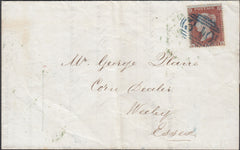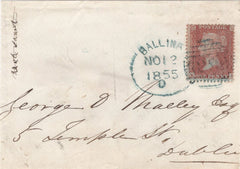Coloured Cancellations
-
Filter by plate
-
Sort by
The Maltese Cross was introduced in May 1840 to cancel the 1d black and the 2d blue - postal regulations demanding that it be struck using red ink. In Feb 1841 the colour of the 1d value was changed to red and the cancellation was changed to a black ink. It is possible to find usages that contravene these regulations . from August until November 1840 there was an experimental use of black ink in London - it is not that scarce a usage but a nice item to have. The 1d red cancelled with a red cancellation is a rare item - whether it is Maltese Cross, 1844 numeral , sideways duplex ( a few examples of the Kidderminster sideways duplex are recorded) or a Spoon cancellation ( a single strike on an unpaid cover exists). Occasionally one sees the use of blue ink with Maltese Crosses, 1844 numerals (quite common), sideways duplex and Spoons both English and Irish types. Green cancellations can be problematic as the oily mixture of the ink can change over the years and in 30 years I have yet to see either a convincing English Maltese Cross or 1844 numeral in green - from Ireland yes , but the best examples of green cancellations are the green Irish spoons. Yellow is a rarity and has usually occurred when the postal clerk has incorrectly used his yellow back stamp pad. Other colours - Magenta, Brown ( sometimes caused through oxidisation), Purple and other variants are available along with a fine range of reds - such as vermilion - blood red and many other distinctive shades. Certain colours in my opinion must have a genuine RPS or BPA certificate and when considering such pieces the colour of the back stamp can be very important. There are some excellent books on the subject and key on this area of collecting is volume 3 of the Jackson Rockoff Maltese Cross encyclopedias (available form this website). Also recommended are the two auction catalogues from Robson Lowe offering the Victoria Collection with superb content and illustrations.
































